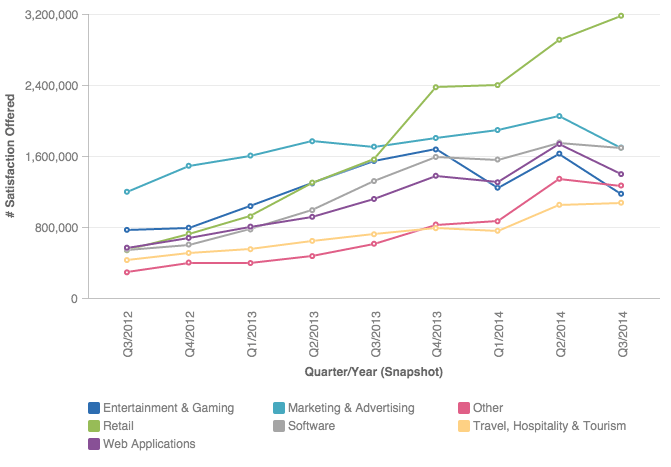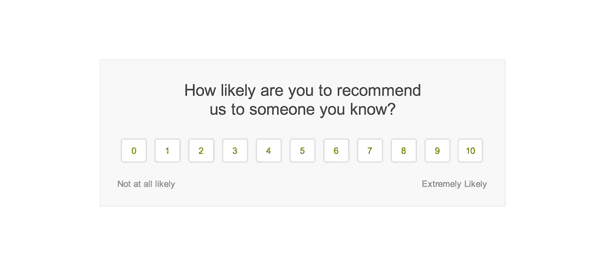Article • 5 min read
Measuring happiness: What's the difference between CSAT and NPS®?
Por Select One
Última actualización el March 11, 2024
Making sure that customers are happy so that they’ll keep coming back is not a new concept. A shop owner looks for a smile and “thank you” to indicate that a customer is happy with a purchase. A restaurant manager can gauge customer happiness with food and service by how much customers eat and by the gratuity they leave. But the strongest affirmation of happiness comes the next time the customer walks back through the shop or restaurant door.
This was all much simpler decades ago when most transactions were handled in person. Today, however, many companies serve their customers online, and so measuring customer happiness requires proactively asking for feedback, usually in the form of surveys. The savviest companies know that it’s important to look at happiness in the short- and long-term. This requires sending out two different types of survey.
Measuring short-term happiness
Customer satisfaction surveys are a simple, commonly-used survey sent to customers shortly after an interaction with a company is complete, such as after a customer has contacted customer support. This type of survey is a great way to close the loop on a customer interaction and make sure that you’ve met their expectations.
Customer satisfaction surveys have grown in popularity, especially in industries like retail where customer satisfaction can ebb and flow due to seasonality. Offering customers an opportunity to give you a quick thumbs up or thumbs down on their latest experience with your brand, helps you to quickly quantify short-term happiness across the entire spectrum of recent customer exchanges.
[Read also: Changing the narrative on careers in customer service]


Yet knowing whether a customer is satisfied with their most recent interaction is not quite enough to gauge long-term happiness and loyalty. Being happy with a single interaction does not necessarily indicate someone’s likelihood to buy something else, or to recommend your company to someone else.
Predicting long-term happiness
One simple way to measure customer happiness over the long-term is by tracking satisfaction throughout a customer’s tenure. Hopefully, you’ll see customer satisfaction increase the longer they are a customer.

While viewing customer happiness this way is useful, there’s still one problem. Even though you’re looking at satisfaction over time, you’re missing a piece of the puzzle because this view gives extra weight to your most vocal customers—the ones who are likely to fill out surveys because they had an extremely good or extremely bad experience—and to your most active customers, who keep coming back and are likely to be fairly happy. What about the silent and potentially large cohort of customers who interact with your company less frequently? This is where the Net Promoter Score℠ (NPS) survey comes in.
Find the right customer support solution
Evaluating vendors can be hard, but help is on the way.
Viewing customer satisfaction over the long-term is useful, but gives extra weight to your most vocal customers.
The NPS survey is a great way to measure how likely a customer will return (or remain loyal), and can help you identify those who are thinking about leaving or are unlikely to do business with you again. That’s because the NPS survey asks the satisfaction question in a different way: “How likely are you to recommend my company to someone you know?”
The customer is then presented with a rating scale of 0-10 (fig. 4). You can read more about the origins of NPS, but essentially this one-question survey serves as an indicator for customer loyalty.

[Read also: Dos and don’ts for marketing with memes]
Customer responses are categorized into three groups:
- Detractors are customers who gave a score of 0 to 6, indicating a dissatisfaction with your company. They are more likely to discourage friends or colleagues from using your product and services.
- Passives are customers who gave a score of either 7 or 8, indicating that they are not likely to actively recommend your company to others.
- Promoters are customers who gave a score of 9 or 10; they are likely to actively recommend your company to others.
Promoters are your loyalists and will spread the good word about your company. Passives may be happy but not quite happy enough to recommend you. Detractors are at risk of taking their business elsewhere—and to tell others to do the same. Your Net Promoter Score is calculated by subtracting your percentage of detractors from your percentage of promoters.

Because NPS is about overall, long-term happiness and not about the latest transaction, companies generally send NPS surveys at a regular interval—such as quarterly or every six months—and the survey goes to a random sample of the overall customer base, and not just to those who recently interacted with the company.
Over time, you’ll want to see your NPS trend upward. To make that happen, you need to pay attention to the most critical component of NPS surveys: the customer’s explanation of why they gave you the rating they did. From this qualitative analysis, you’ll uncover why your detractors are having a bad experience, what’s preventing passives from becoming promoters, and exactly why promoters love your company.
NPS and customers satisfaction surveys are complementary to one another. Customer satisfaction measures short-term happiness on a transactional basis while the other tracks long-term happiness and loyalty. Together, they give you the tools to quantify and improve the overall experience your company provides.
Net Promoter and NPS are registered U.S. trademarks, and Net Promoter Score and Net Promoter System are service marks, of Bain & Company, Inc., Satmetrix Systems, Inc. and Fred Reichheld.
